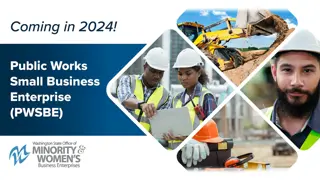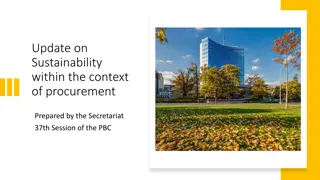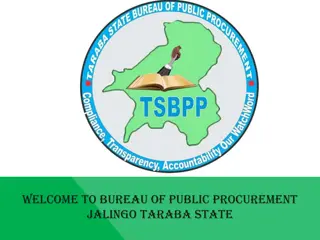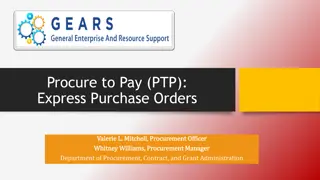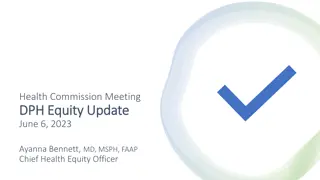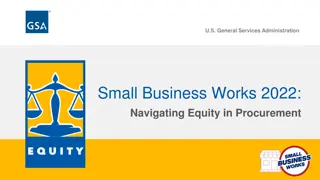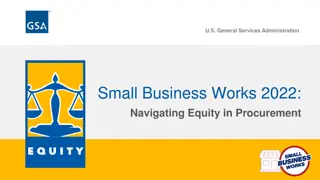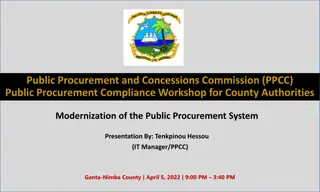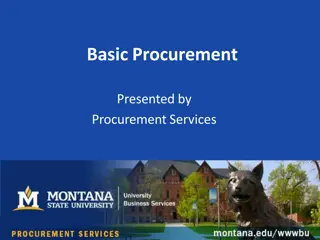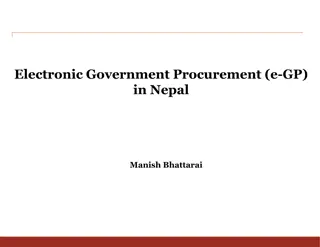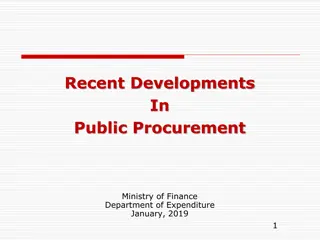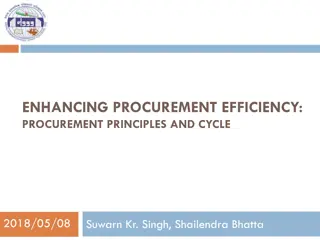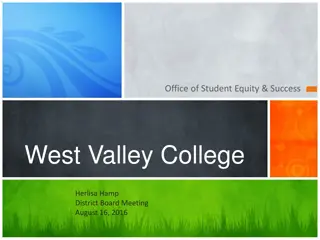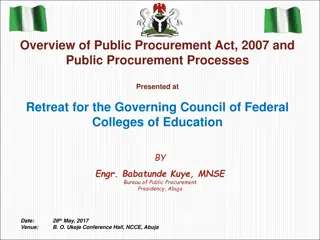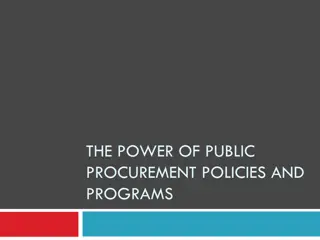Equity in Procurement: Updates and Initiatives for Small Businesses in 2022
Navigating equity in procurement for small businesses in 2022 involves understanding legislative and regulatory updates, such as the National Defense Authorization Act and The Price Act. Executive actions and OMB memorandums are advancing equity by raising governmentwide contracting goals and implementing changes to Category Management to support small businesses.
Download Presentation

Please find below an Image/Link to download the presentation.
The content on the website is provided AS IS for your information and personal use only. It may not be sold, licensed, or shared on other websites without obtaining consent from the author.If you encounter any issues during the download, it is possible that the publisher has removed the file from their server.
You are allowed to download the files provided on this website for personal or commercial use, subject to the condition that they are used lawfully. All files are the property of their respective owners.
The content on the website is provided AS IS for your information and personal use only. It may not be sold, licensed, or shared on other websites without obtaining consent from the author.
E N D
Presentation Transcript
U.S. General Services Administration Small Business Works 2022: Navigating Equity in Procurement
Legislative and Regulatory Updates Sam Le Director of Policy Planning & Liaison U.S. Small Business Administration 2
National Defense Authorization Act for Fiscal Year 2022 Pub. Law 117-81, signed by the President on 12/27/21 Sect. 861 - Keeps the Miller Act threshold for bonding protection for small- business subcontractors on construction projects at its present level, instead of raising it for inflation. Sect. 863 - Requires update to SAM.gov for small business status changes and notification to agencies where the firm has a pending offer, if the change would affect eligibility. Sect. 864 - Gives OHA jurisdiction over HUBZone appeals. Sect. 866 - Requires DoD report on CMMC effects on small business. 4
The Price Act Promoting Rigorous and Innovative Cost Efficiencies for Federal Procurement and Acquisitions Act of 2021 Pub. Law 117-88, signed by the President on 2/22/22 DHS operates a Procurement Innovation Lab aimed at experimenting with innovative acquisition techniques Directs DHS to issue an annual report on innovative procurement techniques, including those used to meet small-business goals. Sunsets after 3 years Requires OMB to convene the CAO Council to examine best practices in acquisition innovation, including in contracting with small businesses CAO Council may form a working group to address CAO Council (or the working group) must issue a report on innovative acquisition techniques that lead to meeting or exceeding small-business goals 5
OMB Memorandum: Advancing Equity in Procurement M-22-03, Dec. 2, 2021 implementing Executive Order 13985 1.Raises governmentwide SDB contracting goal to 11% for FY22, on the way to 15% by 2025. 2.Implements major changes to Category Management. A. automatic Tier 2 credit for socioeconomic small businesses (SDB, WOSB, HUBZone, SDVOSB) B. reinforced importance of small-business goal achievements C. making SBA and Dept. of Commerce voting members on the Category Management Leadership Council. 3.Seeks to increase new entrants and reverse the decline in the small business supplier base. 4.Makes Federal senior managers accountable for small business contracting goals. 5.Ensures OSDBUs have access to senior leadership 7
SBA Disaggregated Data Release SBA.gov as discussed on whitehouse.gov and analyzed by CEA 8
Recent SBA and FAR Regulatory Action
Final Rules (4): Revised Monetary Based Size Standards 87 FR 18607 ; 87 FR 18627; 87 FR 18646; 87 FR 18665 (March 31, 2022) SBA issued four final rules to address monetary-based size standards, including all used in government procurement Reviewed 468 size standards 229 increases No decreases because of COVID-19 Notable changes Engineering Services, 541330 to $22.5 million Administrative Management and Consulting Services, 541611 to $21.5 million Architectural Services, 541310 to $11 million 10
SBA Final Rule: Calculation of Employee-Based Size Standards 87 FR 34094 Adopts a 24-month average to calculate a business s number of employees for size purposes Permits businesses in SBA s loan, SBIC, and surety programs to use 5-year average receipts, in addition to 3-year average receipts 11
SBA Proposed Rule: Manufacturing and Employee-Based Size Standards 87 FR 24752 (April 26, 2022) Reviewed 432 employee-based size standards Proposed to increase 150 size standards 120 of the increases are in manufacturing industries Proposed to retain 282 size standards Proposes to retain the 500-employee size standard for the nonmanufacturer rule If finalized, would add 250 small businesses 12
SBA Proposed Rule: Adoption of 2022 NAICS for Size Standards 87 FR 40034 (July 5, 2022) Proposes to reorganize SBA s size standard table for OMB s new NAICS revision. New NAICS codes were effective in January. The NAICS 2022 revision creates 111 new industries. Comments due August 4. 13
Direct Final Rule: Definition of Surviving Spouse/Change to Sole-Source Thresholds 86 FR 61670 Allows surviving spouse of deceased service-disabled veteran to qualify as owner of SDVOSBC for up to: 10 years after veteran s death, if veteran was 100% disabled 3 years after veteran s death, for less than 100% disability Changes 8(a) sole-source J&A threshold to $100 mil for DoD, $25 mil for civilian Applies to entity-owned (ANC/Tribe for DOD & civilian agencies; NHO for DOD only) firms and Applies if only one eligible Participant would submit a fair-market offer Changes sole-source thresholds in 8(a), WOSB, and HUBZone to: $4.5 mil for nonmanufacturing (but still $4 mil in SDVOSBC) $7 mil for manufacturing (same for SDVOSBC) 14
Proposed Rule: Veteran-Owned, Service-Disabled Veteran-Owned Certification 87 FR 40141 Would establish an SBA certification program for VOSBs and SDVOSBs Generally, SBA adopts existing application requirements from the VA SBA considering eliminating incarceration from the "good character" requirement for certification Certification is required for set-aside or sole source SDVO or VOSB contracts Eligible for a term of three years from certification Currently VA verified-firms maintain eligibility through transfer date Self-certified firms must apply within one-year grace period Comments due August 5 15
Direct Final Rule: HUBZone Governor-Designated Covered Areas 84 FR 62447 Added new type of HUBZone: Governor-Designated Covered Area Non-urbanized areas with populations of 50,000 or less Unemployment of at least 120% the state or US average Opportunity Zones encouraged Governors must petition SBA limited toone petition per year Published November 11, 2019 Effective January 1, 2020 Illinois, Colorado, and Virginia granted expansions 16
Direct Final Rule: Extending HUBZone Map Freeze 86 FR 23863 Extends the HUBZone Map freeze until June 30, 2023 Qualified census tract data using the 2020 Census results will not be available until late 2022. Applies to all current Redesignated Areas and Qualified Base Closure Areas, and most current Qualified Disaster Areas. The HUBZone Map has been updated to reflect the new expiration date forthose areas. After SBA receives the Census data from HUD, SBA will post a list identifying areas newly designated as Qualified Census Tracts, Qualified Non- metropolitan Counties,and Redesignated Areas, so that firms can plan accordingly. 17
HUBZone: New Qualified Non-Metropolitan Counties 84 FR 65222 In early August, the HUBZone Map was updated to add 452 new Qualified Non-Metropolitan Counties (QNMCs). This update is in response to a statutory change to the definition of the term Qualified Non Metropolitan County that went into effect in 2020. SBA conducted an analysis using the amended definition to identify additional non metropolitan counties that would qualify as QNMCs and have added them to the HUBZonemap. 18
SBA Proposed Rule: Past Performance Ratings for JV members and Subcontractors 86 FR 64410 Proposes to let small business use past performance from a joint venture, provided it worked on the joint venture s contracts Proposes to let a small business use past performance from a first-tier subcontract to go after a prime contract Requires a change to subcontracting plans to direct primes to provide a rating to the small business within 15 days Requested comment on whether to require a time frame within which the small business must make the request (e.g., during the prime s period of performance) 19
Nonmanufacturer Rule Class Waiver: Dental Equipment 87 FR 31292 SBA issued a class waiver under NAICS code 339114 for: dental chairs, dental delivery systems, dental lights, dental cabinets, dental stools, dental handpieces, dental infection control apparatus, dental air management systems, and mechanical room equipment Allows otherwise qualified regular dealers to supply the waived items on certain small business contracts, regardless of the business size of the manufacturer. 20
Nonmanufacturer Rule Class Waivers: Terminations 87 FR 29424 (radiology equipment); 87 FR 34921 (furniture) SBA terminated the class waivers of the nonmanufacturer rule for; radiology equipment, NAICS code 334517; and furniture under NAICS codes 337215, 337127, and 337113. Small businesses will need to provide the product of a small- business manufacturer for set-aside contracts, unless the agency obtains an individual waiver. 21
Notice of new WOSB Program NAICS Codes 87 FR 15468 (March 18, 2022) SBA identified new NAICS codes for the WOSB program Underrepresented industries are qualified for EDWOSB set-asides/sole- source procurements 113 underrepresented NAICS codes Substantially underrepresented industries are qualified for WOSB set- asides/sole-source procurements 646 substantially underrepresented NAICS codes 22
FAR Final Rule: Small Business Programs Overseas 87 FR 24836 Amends FAR 19.000 to specify that agencies may apply Part 19 (Small Business Programs) outside the United states and its outlying areas. If applied, participants must meet definition of small business concern And must submit representations Note: SBA definition of Small business concern at 13 CFR 121.105: place of business located in the United States, and which operates primarily within the United States or which makes a significant contribution to the U.S. economy through payment of taxes or use of American products, materials or labor. Applies bundling definition to contracts performed entirely outside the U.S. (they previously were exempted) 23
FAR Final Rule: Limitations on Subcontracting 86 FR 44233 Applies across all small business programs Calculated as a percentage of the overall contract amount to be spent by the prime contractor on subcontractors. Similarly situated entity a small business subcontractor that has the same small business program status as that which qualified the prime contractor for the prime contract Nonmanufacturer rule does not apply to small business set-asides at or below the simplified acquisition threshold Waivers of the nonmanufacturer rule allowed for procurements under the HUBZone Program 24
FAR Final Rule: Scope of PCR Review 86 FR 44247 COs must provide the PCR a copy of any proposed acquisition package, at the PCR s discretion PCRs may recommend the set-aside or sole-source award to a small business; the breakout of discrete components, items, and requirements for competition; and ways to improve competition 25
FAR Final Rule: Good Faith in Small Business Subcontracting 86 FR 44249 Provides examples of activities that contracting officers may consider when evaluating whether the prime contractor made a good faith effort to comply with its small business subcontracting plan. Requires prime contractors with commercial subcontracting plans to include indirect costs, with certain exceptions, in their subcontracting goals 26
FAR Final Rule: Consolidation and Bundling 86 FR 61038 Requires the publication on SAM.gov of a notice, no later than 7 days before the solicitation, for Substantial bundling, and for Consolidation Requires the publication on SAM.gov of a determination, with the publication of the solicitation of The rationale for substantial bundling, or that Consolidation of contract requirements is necessary and justified 27
FAR Proposed Rule: Small Business Program Amendments 87 FR 10327 Size changes Size determined at offer on a multiple-award contract, even if price not evaluated (e.g., two-step eval) IT value-added reseller size standard of 150 employees Allow status protests based on ostensible subcontractor Allow set-asides for socioeconomic programs where multiple-award contract was set aside for small business Cannot exercise an option past 5thyear on an 8(a) contract if firm is no longer an 8(a) participant 28
FAR Proposed Rule: Update of HUBZone Program 86 FR 31468 Published June 14, 2021 Implements SBA's comprehensive revision (84 FR 65222) Removes requirement for firm to be HUBZone qualified at both offer and award for HUBZone set-asides instead just offer Authorizes sole source awards under SAT 29
FAR Proposed Rule: WOSB Certification 86 FR 55769 Would require agencies to check SBA s DSBS for WOSB/EDWOSB designation for WOSB/EDWOSB set-asides and sole-source awards Firms may submit offers no WOSB/EDWOSB set-asides if certification is pending Would remove mentions of the WOSB repository, which no longer exists 30
Questions? 31





